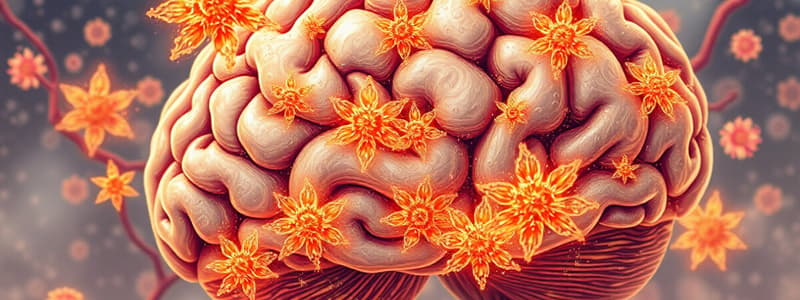Podcast
Questions and Answers
Which statement accurately describes kainate receptors?
Which statement accurately describes kainate receptors?
- Kainate receptors are impermeable to Na+ and K+.
- Kainate receptors primarily allow the flow of Ca2+ ions.
- Kainate receptors are exclusive to the GluK1 subunit only.
- Kainate receptors can be activated by domoic acid. (correct)
What is a potential consequence of excessive glutamate receptor activation?
What is a potential consequence of excessive glutamate receptor activation?
- Increased neuronal repair processes.
- Decreased susceptibility to neurotoxins.
- Excitotoxicity resulting from elevated intracellular Ca2+. (correct)
- Enhanced synaptic transmission and plasticity.
Which of the following statements about GluD1 and GluD2 is correct?
Which of the following statements about GluD1 and GluD2 is correct?
- GluD1 and GluD2 are primarily responsible for excitotoxicity.
- GluD1 and GluD2 may play a role in synaptic plasticity. (correct)
- GluD1 and GluD2 are only associated with epilepsy.
- GluD1 and GluD2 are confirmed ligand-binding receptors.
Which neurotoxin is specifically an analogue of glutamate?
Which neurotoxin is specifically an analogue of glutamate?
What condition is associated with mutations in the GluA3 subunit?
What condition is associated with mutations in the GluA3 subunit?
Which of the following correctly describes the NMDA receptor's activation mechanism?
Which of the following correctly describes the NMDA receptor's activation mechanism?
What channels are NMDA receptors highly permeable to?
What channels are NMDA receptors highly permeable to?
What role does ketamine play in relation to the NMDA receptor?
What role does ketamine play in relation to the NMDA receptor?
Which NMDA receptor subunit mutation is associated with focal epilepsy?
Which NMDA receptor subunit mutation is associated with focal epilepsy?
What is a significant characteristic of AMPA receptors?
What is a significant characteristic of AMPA receptors?
Amantadine acts as a channel blocker at NMDA receptors. What is its other significant use?
Amantadine acts as a channel blocker at NMDA receptors. What is its other significant use?
Kainate receptors are associated with which of the following characteristics?
Kainate receptors are associated with which of the following characteristics?
Which feature differentiates AMPA receptors from NMDA receptors?
Which feature differentiates AMPA receptors from NMDA receptors?
What type of receptors do ionotropic glutamate receptors belong to?
What type of receptors do ionotropic glutamate receptors belong to?
Which of the following subunits is NOT part of the NMDA receptor composition?
Which of the following subunits is NOT part of the NMDA receptor composition?
Which cation has high permeability at NMDA receptors?
Which cation has high permeability at NMDA receptors?
Which ionotropic glutamate receptor primarily mediates fast excitatory neurotransmission?
Which ionotropic glutamate receptor primarily mediates fast excitatory neurotransmission?
What is a key characteristic of ionotropic glutamate receptors' structure?
What is a key characteristic of ionotropic glutamate receptors' structure?
Which drug acts as an open channel blocker at NMDA receptors?
Which drug acts as an open channel blocker at NMDA receptors?
Which receptor type contains glutamate as its primary ligand?
Which receptor type contains glutamate as its primary ligand?
Which of the following statements is true regarding kainate receptors?
Which of the following statements is true regarding kainate receptors?
Which substance is described as the principal excitatory neurotransmitter in the central nervous system?
Which substance is described as the principal excitatory neurotransmitter in the central nervous system?
What action does Sodium Valproate perform in relation to glutamate?
What action does Sodium Valproate perform in relation to glutamate?
Flashcards are hidden until you start studying
Study Notes
Ionotropic Glutamate Receptors
- Ionotropic glutamate receptors are a type of ligand-gated ion channel, which are activated by the neurotransmitter glutamate.
- There are three main types of ionotropic glutamate receptors: NMDA, AMPA and Kainate.
- Glutamate is the main excitatory neurotransmitter in the central nervous system.
- Ionotropic glutamate receptors are tetramers, composed of four protein subunits.
- The subunits can be either homo-oligomers (AMPA receptors), or hetero-oligomers (NMDA, kainate receptors).
NMDA Receptors
- NMDA receptors are composed of GluN1, GluN2A, GluN2B, GluN2C, GluN2D, GluN3A, and GluN3B subunits.
- NMDA Receptors are permeable to sodium (Na+), potassium (K+), and calcium (Ca2+).
- Activation of NMDA receptors requires binding of both glutamate and the co-agonist glycine.
- NMDA receptors have a magnesium (Mg2+) block, which is relieved upon membrane depolarization.
- The channel is then able to conduct, allowing calcium to flow into the cell, which mediates long-term potentiation (LTP).
- Ketamine acts as an open channel blocker at NMDA receptors, used as an anaesthetic.
- Amantadine acts as a channel blocker at NMDA receptor, used to treat Parkinson's disease.
AMPA Receptors
- AMPA receptors are made up of GluA1, GluA2, GluA3 and GluA4 subunits.
- AMPA receptors are permeable to Na+, K+, and some Ca2+.
Kainate Receptors
- Kainate receptors can be expressed as homooligomers of GluK1, GluK2, or GluK3 subunits.
- Kainate receptors are permeable to Na+ and K+, with little permeability to Ca2+.
GluD1 and GluD2
- GluD1 and GluD2 are 'orphan' receptor subunits with no confirmed ligand.
- May be involved in synaptic plasticity.
Drug Targets: AMPA, Kainate, and NMDA Receptors
- Excitotoxicity: can occur from a rise in intracellular Ca2+ due to glutamate receptor activation.
- Neurotoxins: domoic acid, β-N-oxylaminoalanine (BOAA) and β-N-methylamino-L-alanine (BMAA) all act as glutamate analogues, and can cause excitotoxicity.
- Ischaemic neuronal death: NMDA and AMPA receptors have been shown to be involved in this pathway.
- Phencyclidine (PCP) and Ketamine are channel blockers at NMDA receptors, used as dissociative anaesthetics.
- Mutations in glutamate receptors have been associated with epilepsy.
Domoic Acid Poisoning
- Domoic acid is a neurotoxin from the seaweed Pseudo-nitzschia.
- Found in mussels, and can cause domoic acid poisoning.
Studying That Suits You
Use AI to generate personalized quizzes and flashcards to suit your learning preferences.



